Truck Company | By John Simpson
Often when we teach vent-enter-search (VES), we instruct crews to break out the window and sweep and clean the frame out so we don’t get cut on any shards of glass or hung up when entering or exiting the structure. After that, we teach them to sweep the floor for any possible victims and sound the floor for stability. In many cases, we don’t even have windows for the students to remove, and we must substitute with props. Some of the props are realistic and some are not. In addition, many instructors teach crews that they should only bring a hook and a halligan for VES operations.
This article will cover some of the obstacles that may create challenges in venting and making entry into the VES room. Quite often during training, we must make do with what we have to work with, building-wise and prop-wise. We can occasionally purchase some manufactured props but, more often, we must use our imaginations. For example, we can use black plastic stapled to a wood frame with a dowel rod or strip of wood to simulate the sash. We can also use drywall, which is more difficult to break and will make firefighters work harder to clear the window.
Often during training, we simply don’t encounter the same obstructions we would experience in the streets, such as hurricane windows, hurricane shutters, burglar bars, heavy duty screens, plywood, and more. Even once the window is cleared, we may encounter obstacles inside like headboards and dressers. We should make training as realistic as possible.
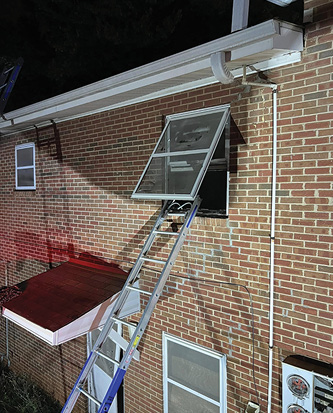
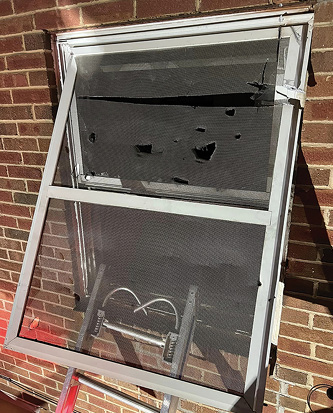
1. & 2. The heavy-duty screen that firefighters from Charlotte Tower 18 encountered. (Photos by author unless otherwise noted.)
Challenges with Entry
Recently, members of Charlotte (NC) Fire Department Tower 18 encountered heavy duty window screens while they attempted to VES. The screens were on a row house that was formerly Section 8 housing. While attempting to remove them, they found that the screen material was almost an expanded metal and the frames were stronger than expected and hinged at the top. This made more common forcible entry tactics for removal a challenge, and firefighters also considered using power tools to force these screens open (photos 1 and 2). In addition, it would add challenges for removing the window, entering, and removing a victim.
Burglar bars. Obstructions like burglar bars can slow us down making entry. Knowing tactics for removing them will speed up the process. Even so, we may need more than just a hook and a halligan. Tools such as a sledge, rotary saws (gas or battery operated), and portable cutters would also be helpful.
Hydraulic rescue tools. We can also use battery-operated hydraulic rescue tools. When defeating burglar bars, we should tackle them at the points of contact with the building. Some burglar bars may have hinges on one side with a padlock or key in the knob lock on the opposite side. If you attack opposite the hinge side without cutting the spokes, you can open the bars like a doggie door and start the VES process as your partner completes the removal, all while the room is being isolated and searched.
Hurricane shutters. If you’re not familiar with how they are mounted, hurricane shutters can also prove challenging. Depending on the style, a halligan and hook may work to remove some styles of panels by prying the panel out of the track. This is time-consuming and uses a lot of energy. The easiest and fastest way, again, is using a rotary saw. Cutting the shutter around the frame usually works the best. Make sure you make the cut as big as possible for ease of entry and removal of victims. Use caution when entering, exiting, and removing the victim as edges may be sharp. Again, your partner can clean up the path after you enter the room first.
Plywood coverings. In many cases, plywood coverings can be attached to a building at several points. This offers hurricane protection as well as security (photo 3). The easiest way to tackle this style of covering is with a rotary saw or chainsaw. If the wood covering’s installation meets HUD specifications, the fastest way to attack them would be with an ax and halligan—drive the carriage bolts through the wood or split the exterior wooden cross members.
Another way to handle plywood coverings is to cut the bolt heads off with a rotary saw. If a chainsaw is available, do an inspection cut first. This enables you to see if the windows are still intact or have been removed to allow the cross members to be put in place. Cut down the center of the plywood. Make sure to bury the bar as deep as possible. This allows you to cut the inside and outside brace.
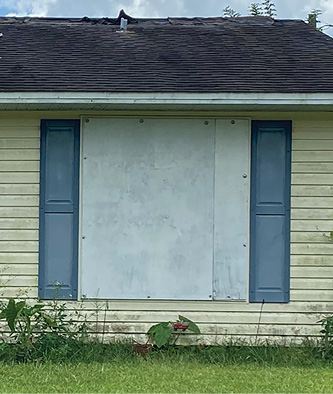
3. Plywood coverings are often used for hurricane protection or security.
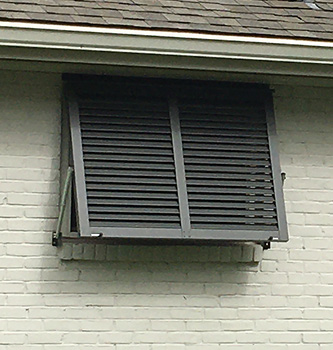

4. & 5. Working shutters are often used in the South or in hurricane-prone areas.
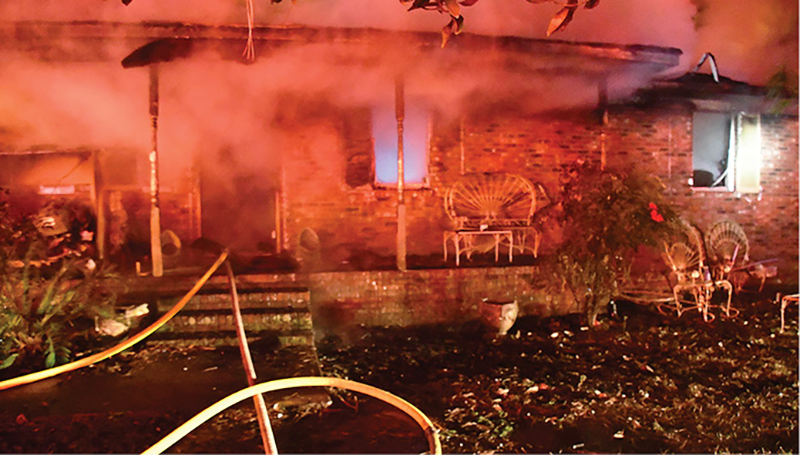
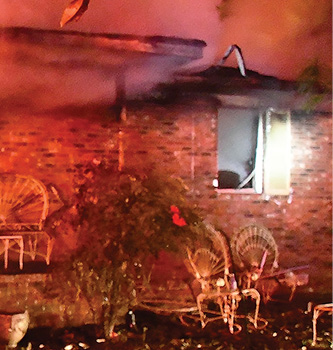
6. & 7. Colleton County firefighters attempted to VES the side-A window at the right to rescue a trapped occupant. A firefighter was unable to enter the window due to a headboard approximately 12 to 16 inches above the windowsill. This put the firefighter in the upper atmosphere of the window, and he began to receive burns.
Window screens and working shutters. Often found in the South, working shutters are attached to buildings year-round. These offer shade during times when storms or hurricanes aren’t a threat. They can be closed and locked into position when a storm approaches (photos 4 and 5). Depending on how they are mounted, working shutters can prove difficult to force open.
Some heavy duty screens and working shutters may be attached at the side and open like a door. Sometimes they’re hinged at the top and will be a little harder to remove. Again, the best way to tackle them is with the rotary saw. If a tower ladder or an aerial is available, use them to give you a working platform. This will make the removal process easier.
Hurricane windows. Another challenge is hurricane windows. This glass is extremely hard to break and remove. The frame is reinforced and the mounting to the building is also reinforced with bigger and longer screws. Like the other challenges, this slows us down when we’re trying to complete VES. Some hurricane windows can be chopped or beaten with an ax. This is time-consuming and uses quite a bit of energy. If you do it, try cutting three sides and leaving the bottom portion attached so it flaps inward or outward. This will reduce the time factor.
You can use a battery-operated reciprocating saw, but first you must put a hole in the glass with an ax and the pike of the halligan. This is another example where the fastest route is using a rotary saw with a diamond blade. (A carbide tip blade will work as well but presents the hazard of larger pieces of glass being discharged.) Cutting hurricane glass requires caution, as the dust can be inhaled, and a flying shard of glass can cause injury and other medical problems. You should use self-contained breathing apparatus or an N95 mask and wear appropriate safety protection on your face and eyes.

8. Firefighters had to move a dresser while performing VES. (Photo by Bob Faas.)
Beyond the Cleared Window
After you clear the window, you still may not have a clean shot of getting into the room. Here are a few steps to take. Start by removing any curtains or blinds. Next, look for other obstructions that may hinder you from easy entry. Headboards can make it difficult to enter and remove a victim. Recently in Colleton County, South Carolina, firefighters encountered this very problem while attempting to VES a room with a known victim in it. The window was removed, and a firefighter attempted to enter over the headboard. He encountered high heat and began to feel it through his gear. He moved to another window and entered the room on the D side of the house (photos 6 and 7).
Residents often put dressers in front of windows and nightstands under windows. Sometimes you can move them and other times you will have to go over them. Remember that even with these obstacles, attempt to sweep and sound the floor as much as possible (photo 8).
In a manufactured home, I encountered a mattress that was 4 to 5 inches higher than the windowsill, and the windowsill was 5½ feet off the ground. I used a halligan as a step to gain entry through the window. With the mattress in the way—and standing on the halligan—I was not able to sweep and sound the floor. Getting on top of the mattress was a challenge as well. I had to pull myself up by grabbing the other side of it while my partner, outside the window, pushed my legs as I was pulling.
These are just a few of the obstacles you may encounter while performing VES. Get out into your areas and learn more about what you may run into. Also, EMS runs can provide you with information if you just look around. You may encounter these same obstacles or different ones. Our tactics and tools must change as we face these obstacles. Make your training as realistic as possible.
JOHN SIMPSON is a 44-year veteran of the fire service and is a firefighter/EMT with Malabar (FL) Fire Rescue. He recently retired from Osceola County (FL) Fire Rescue Tower Ladder 72. He previously served with the Titusville (FL) Fire Department as well as the Palm Bay (FL) Fire Rescue and the Peters Township (PA) Fire Department. He is an FDIC instructor and an instructor with On-Scene Training Associates, teaching nationally and internationally. Also, he has been the lead instructor for his department’s Truck Company Operation class. Simpson is a founding member of F.O.O.L.S. International.

